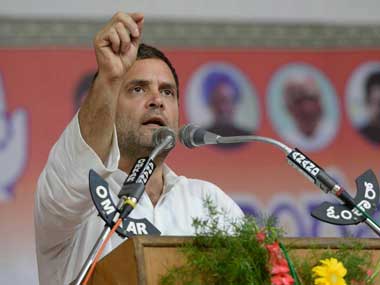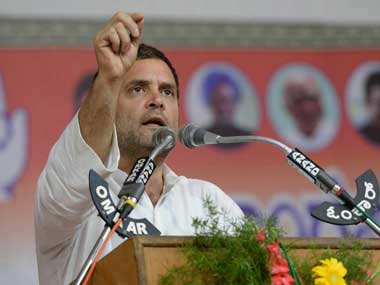Congress President Rahul Gandhi’s candidature from the Wayanad Lok Sabha constituency in northeast Kerala has dampened spirits in the state’s Left camp. Senior leaders of the Communist Party of India (Marxist), which heads the ruling Left Democratic Front (LDF) in the state, have been trying to keep the morale of the cadres high, saying they will settle scores with the Congress for deciding to fight the Left in the state instead of the BJP after the Lok Sabha election. However, party workers are doubtful whether the Left will have enough MPs to call the shots if the situation warrants their support to form a secular government at the Centre after the election. Left parties had played a decisive role in the formation of a government by the Congress-led United Progressive Alliance (UPA) in 2004 as they had 59 MPs then. That was the time when the Left dominated the politics in West Bengal, Kerala and Tripura. But the situation has changed, with the Trinamul Congress and the BJP ending the Left monopoly in West Bengal and Tripura, respectively. [caption id=“attachment_4449509” align=“alignleft” width=“380”] File image of Congress president Rahul Gandhi. Twitter@INCIndia[/caption] The Left tally has been witnessing a steady decline since 2004. The number of their MPs plummeted to 24 in 2009 and to just nine in 2014. With no sign of revival in West Bengal and Tripura, CPM has been pinning a lot of hope on Kerala to regain its lost political clout at the Centre. Local CPM leaders have been predicting a repeat of 2004, when the Left won 18 of the 20 Lok Sabha seats in Kerala for the first time in the state’s electoral history. Party strategists have been hoping that the proactive stand their government took on the Sabarimala issue may bring them the support of minorities, who account for 46 percent of Kerala’s population, and keep its tally high. However, Rahul’s entry in the fray in Wayanad has upset the calculations of the Left parties. Observers believe that the Congress leadership may have selected Wayanad as the second seat for Rahul with exactly this in mind. The Congress appears to want to eliminate the Left from the post-poll scene to ensure that they do not call the shots, if at all the party requires a post-poll alliance to form a government at the Centre. The grand old party has bitter memories from 2008, when the Left Front had sought to dislodge the then UPA government led by Manmohan Singh by withdrawing their support from the alliance in protest against the decision to go ahead with the India-US civilian nuclear deal. The UPA government had survived the crisis with the support of the Samajwadi Party, Janata Dal (Secular) and Rashtriya Lok Dal. Setting these bitter memories aside, the Congress was ready to align with the CPM in West Bengal and other states where the party has its pockets of influence. But the tall claims of the CPM and its partners derailed the alliance talks, forcing a quadrangular contest in most seats in the eastern state. The Congress apparently construed this as an opportunity to crush the Left Front. Sources in the Congress said the decision to field Rahul from Wayanad was made after different levels of the party deliberated on its pros and cons. The sources added that former chief minister and Congress Working Committee member AK Antony and All India Congress Committee (AICC) organising general secretary KC Venugopal were the brains behind the move. They appraised Rahul that the coalition led by the United Democratic Front (UDF) in Kerala would be able to win all 20 seats in the states if he contested the election from Wayanad.
File image of Congress president Rahul Gandhi. Twitter@INCIndia[/caption] The Left tally has been witnessing a steady decline since 2004. The number of their MPs plummeted to 24 in 2009 and to just nine in 2014. With no sign of revival in West Bengal and Tripura, CPM has been pinning a lot of hope on Kerala to regain its lost political clout at the Centre. Local CPM leaders have been predicting a repeat of 2004, when the Left won 18 of the 20 Lok Sabha seats in Kerala for the first time in the state’s electoral history. Party strategists have been hoping that the proactive stand their government took on the Sabarimala issue may bring them the support of minorities, who account for 46 percent of Kerala’s population, and keep its tally high. However, Rahul’s entry in the fray in Wayanad has upset the calculations of the Left parties. Observers believe that the Congress leadership may have selected Wayanad as the second seat for Rahul with exactly this in mind. The Congress appears to want to eliminate the Left from the post-poll scene to ensure that they do not call the shots, if at all the party requires a post-poll alliance to form a government at the Centre. The grand old party has bitter memories from 2008, when the Left Front had sought to dislodge the then UPA government led by Manmohan Singh by withdrawing their support from the alliance in protest against the decision to go ahead with the India-US civilian nuclear deal. The UPA government had survived the crisis with the support of the Samajwadi Party, Janata Dal (Secular) and Rashtriya Lok Dal. Setting these bitter memories aside, the Congress was ready to align with the CPM in West Bengal and other states where the party has its pockets of influence. But the tall claims of the CPM and its partners derailed the alliance talks, forcing a quadrangular contest in most seats in the eastern state. The Congress apparently construed this as an opportunity to crush the Left Front. Sources in the Congress said the decision to field Rahul from Wayanad was made after different levels of the party deliberated on its pros and cons. The sources added that former chief minister and Congress Working Committee member AK Antony and All India Congress Committee (AICC) organising general secretary KC Venugopal were the brains behind the move. They appraised Rahul that the coalition led by the United Democratic Front (UDF) in Kerala would be able to win all 20 seats in the states if he contested the election from Wayanad.
The panicky reactions of Left and BJP leaders to the move convinced the AICC leadership that Rahul’s candidature from Wayanad may kick off a wave in favour of the Congress and its allies not only in Kerala but also in neighbouring Tamil Nadu and Karnataka.
Rahul also saw this as an opportunity to rein in the warring factions in the Kerala Congress unit. His nod to contest the seat had the effect of a masterstroke on the leaders of the factions, who buried their differences on the selection of candidate and hit the ground to gain maximum electoral mileage from Rahul’s candidature. In the same move, Rahul also sought to liberate himself from the influence of loyalists of his mother Sonia Gandhi, whose lineup began with Antony down to PC Chacko, KV Thomas, PJ Kurien and the like. KV Thomas had virtually enacted a drama when his name did not figure in the Congress list of candidates as he had been replaced by Hibi Eden in Eranakulam. Former Rajya Sabha deputy chairman PJ Kurien, who has no love lost for former chief minister Oommen Chandy, has his own “private” faction within the group. He had made certain proxy moves using Kerala Congress maverick PC George to foment trouble in the key Pathanamthitta constituency for sitting MP Anto Antony. Kurian is believed to have had an eye on the seat, though he had ruled himself out of the race. Rahul’s hardened stance was prompted by an unseemly fight between Chandy and Leader of the Opposition Ramesh Chennithala over the Wayanad seat, where T Siddique, a staunch Chandy loyalist, was propped up as a probable initially. But Chennithala led an open revolt against Siddique, as traditionally, the seat was supposed to belong to the ‘I’ group he led. Sitting MP MI Shanvas, who died towards the end of his term, had always been identified as a Chennithala man. However, neither Chandy nor Chennithala had any inkling of what was coming, especially since an impression was sought to be created that Rahul’s Wayanad move was out of question. This forced the two to distance themselves from the move.
The decision has rattled the CPM most as it will have far-reaching consequences on its political future. Apart from the possible loss of electoral gains, the party is also worried about the prospect of losing its “national” tag if it does not win at least 11 Lok Sabha seats in the upcoming election.
According to the Election Symbols (Reservation and Allotment) order, a party gets national status only if it has 11 Lok Sabha MPs from at least three states, or polls at least 6 percent of votes in the Lok Sabha and Assembly polls in at least four states in addition to winning 4 Lok Sabha seats. The CPM currently fulfils the criteria as a state party in West Bengal, Kerala and Tripura. Its Lok Sabha tally in 2014 was nine seats and a 3.25 percent share of votes. The loss of national status will deprive the party of many privileges, such as free airtime on national media for campaigning and exemption of travel expense by 40 VVIP campaigners from being billed to the candidate. The Left party is trying to prevent this by launching a no-holds-barred campaign against the Congress. Party state secretary Kodiyeri Balakrishnan has hinted at the shape of the campaign by portraying Rahul as a candidate of radical Muslim groups like the Jama’at-E Islami and the Social Democratic Party of India (SDPI), the political avatar of the National Development Front, a fundamentalist outfit. Kodiyeri has attributed communal colour to the contest as Muslims form a majority in Wayanad, and they owe their allegiance mostly to Indian Union Muslim League, the second largest constituent of the UDF. “The Muslim League has more influence in Wayanad than the Congress. The League has already formed an alliance with the Jama’at-E-Islami and the SDPI. In effect, Rahul will be contesting as the joint candidate of the Congress-Jama’at-SDPI alliance,” CPM mouthpiece Deshabhimani quoted Balakrishnan in an article. He said defeating Rahul in Wayanad had become the CPM’s responsibility, and the party will do everything possible to ensure it. The party has also started digging up old issues such as the 2G spectrum corruption case and the coal block allocation scam to attack the Congress. The BJP is also gearing up to put up a big fight in Wayanad by fielding a strong candidate against Rahul. Kerala BJP president PS Sreedharan Pillai said the national leadership of his party will soon announce a formidable candidate. With both the LDF and the BJP preparing for a strong campaign against Rahul, the national spotlight will be on Wayanad.
)